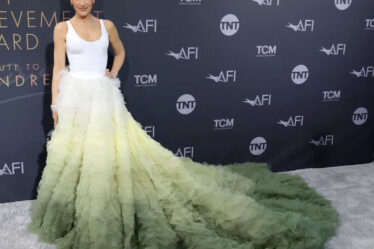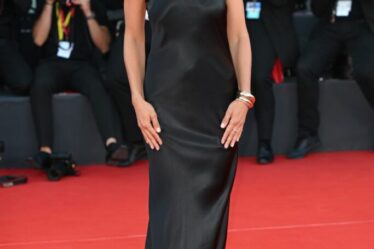“The only guy here without a trust fund,” reads British influencer William Wade’s tongue-in-cheek caption on an Instagram post from the ritzy Swiss ski town St. Moritz.
His caption isn’t such a stretch: Aside from a handful of mountain sports fanatics, skiing is largely reserved for the wealthy, with resorts catering to clients willing to spend thousands on gear, lift passes, $60 schnitzels and hotels whose prices soar during peak season.
This ambience was home turf for luxury outerwear companies like Moncler Group (which also owns Stone Island), Canada Goose and newer entries like Perfect Moment, which went public last year. Their success has inspired luxury fashion giants like Chanel, Dior and Armani to launch ski wear capsules and open new boutiques in mountain resorts, alongside dealers for Rolex and Cartier.
Even more recently, a crop of outsiders like Zara, Jacquemus, Kiehl’s, Ilia and Boohoo — who previously had little exposure to winter sports or their top-spending clientele — are joining the race to leave their mark in the snow. They are launching capsule ski collections, staging content for socials in ski resorts, placing giveaways near the slopes and opening pop-ups and boutiques in ski towns in Switzerland, France, the United States and China.

Meanwhile, luxury brands are defending their territory, ramping up both marketing and positioning. Moncler has repositioned its Grenoble line, with a clearer focus on high performance ski wear. In December 2023, the group opened its first-ever Moncler Grenoble flagship store in St. Moritz and staged a runway show on the resort’s slopes just a few months later.
The newer entrants’ efforts likely have less to do with directly competing with seasoned ski wear players than tapping into the sport’s growing audience and the allure of its retro winter vibe.
“We live in an experience generation where everybody wants to try new things at least once, especially sports like surfing, tennis and skiing,” said David Ogiste, founder of creative agency Nobody’s Café. For the generation that prefers to splurge on the experience, “gear needs to look the part without breaking the bank,” Ogiste said. “Are you going to buy performance luxury products if you’ll never wear them again?”
#WinterVibes
Enter Zara Ski. The Inditex giant’s latest outerwear capsule capitalises on what it does best — offering alternatives to trendsetting luxury designs at accessible prices — this time replicating the aesthetic of glitzy mountain brands.
Initially launched three years ago, the fast fashion giant’s skiwear line drew attention this season thanks to pop ups in Shanghai (all pink) and Verbier (igloo-shaped) with influencers heavily sharing the stores and merchandise. Zara’s approach to ski is less about showing off than showing up in something that’s “good looking for a good price,” said influencer Alice Lee, who purchased items at the Verbier popup.

The collection is “ideal for both the practice of the sport and the enjoyment of après-ski,” Zara said in a statement. The latter points to the importance of popular ‘ski culture’ beyond the actual sport, making for appealing content for brands and influencers alike.
In a bid for winter relevance, additional high-street players like Cos, Arket and Whistles have launched four-figure coats — well above their usual price range — in efforts to tap the dynamic outerwear category and align themselves with the season’s upscale image.
Beyond the high street, bright, white mountain settings lend themselves to wintery campaigns that idealise ski’s sporty aesthetic, romanticising a season otherwise grey and cold. Images from the 90s of Princess Diana elegantly gliding down the slopes are surely on many mood boards.
French designer Jacquemus — fashion’s reigning king of digitally-savvy marketing — doesn’t have a dedicated ski offer, but sought to balance its summery, Provençal image with a ski-inspired campaign in 2023, showing brand favourites like the red Chiquito bag on ski poles and snowy conveyor lifts, reigniting customer interest outside of their usual peak season. The same year, Jacquemus debuted its first mountain boutique in France’s celebrity-favourite ski destination Courchevel, which reopened this season.

A few weeks ago, fast-fashion retailer Boohoo organised an influencer ski trip, where little skiing but lots of ski-adjacent content was created by the invited influencers and Boohoo. “I spent every moment capturing all the details of the trip, bringing to life our branded elements, to our attendees, to the activities itself,” Boohoo’s social media lead Naomi Van Bunnens posted on Linkedin.
In the beauty space, too, winter vibes are getting laid on thick. In 2024, Kiehl’s inked a partnership with US ski resort Jackson Hole, launching a mountaintop skincare “lounge” that spotlighted products for cold climates. An accompanying campaign featured retro ski lockers and slogans about moisturising your Wenis (the often-dry skin on the elbow).

In January 2025, Ilia collaborated with skiwear brand Halfdays to promote its moisturiser Barrier Build. The partnership featured a custom ski suit in Ilia’s signature rose shade (similar to the Zara Ski pink).
A lack of credibility and limited focus on performance has raised heaps of criticism for some of ski wear’s recent entrants. Posts claim the items are not waterproof and otherwise low quality.
Outerwear and sportswear traditionally needed to be as functional as they are aesthetic – unless you are there for the vibe, first and foremost, which is what brands seem to be betting. “Many people go for the atmosphere, they don’t really go skiing at all,” said Ogiste, “They think, ‘since I don’t need a performance outfit, Zara will get me through this trip.’ They can spend less money but still look the part.”
China’s Ski Boom
The momentum around skiing in collections and marketing is underpinned by long-term trends. The ski tourism industry is expected to grow to $5.7 billion by 2027, notably in China where the sport’s infrastructure has rapidly expanded.
Last year, 22 ski resorts were added, bringing China’s total count to 719, while the country registered a 16 percent increase in active skiers. In September, L+Snow, the world’s largest indoor ski resort, opened near Shanghai.
The skiing boom could be one reason outerwear players are outperforming an otherwise sluggish luxury market in China. Moncler has been one of the first brands to recover from a slowdown, with double-digit growth in Mainland China this winter.



